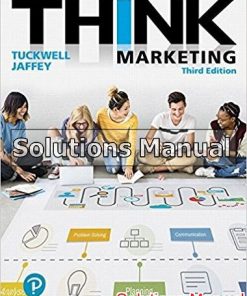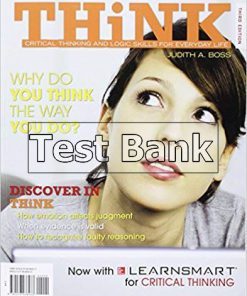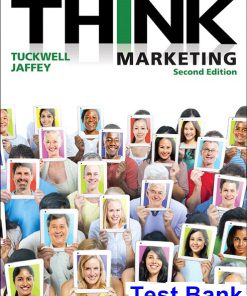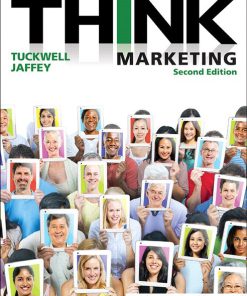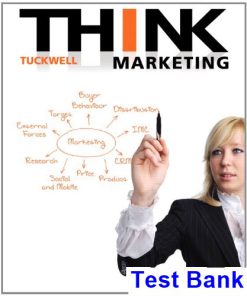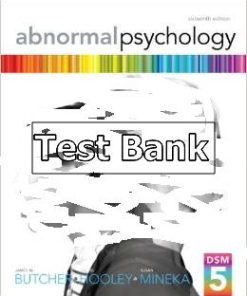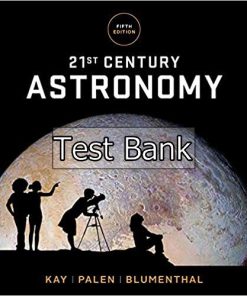THINK Marketing 3rd Edition Tuckwell Test Bank
You may also like
-
$26.50
$50.00
THINK Marketing 3rd Edition Tuckwell Test Bank

Product details:
- ISBN-10 : 0134424719
- ISBN-13 : 978-0134424712
- Author: Keith Tuckwell
The third edition of THINK Marketing makes learning and teaching marketing more effective, easier, and more enjoyable than ever. Its streamlined approach strikes a careful balance between depth of coverage and ease of learning. The third edition’s design enhances student understanding. And when combined with our online homework and personalized study tool, THINK Marketing ensures that you will come to class well prepared and leave class with a richer understanding of basic marketing concepts, strategies, and practices.
Table contents:
- The Third Edition of Think Marketing: Creating More Value for You!
- Marketing: Creating Customer Value and Relationships
- New in the Third Edition
- Overall Presentation of Chapters
- Success Stories Dramatize Marketing Practice
- Students Will Experience Marketing Decisions
- Valuable Learning Aids
- MyLab Marketing
- Teaching and Learning Support
- Acknowledgements
- 1 Contemporary Marketing
- Learning Objectives
- In Just a Short Period . . .
- Marketing Today: Keeping Pace with Change
- Marketing Defined
- The Importance of Marketing
- The Nature of Marketing Has Evolved
- Production Orientation (Early 20th Century)
- Selling Orientation (1920s to 1940s)
- Marketing Orientation (1950s to 1990s)
- Socially Responsible Marketing Orientation (1990s to 2000s)
- Social Media Marketing Orientation (2006 Onward)
- The Marketing Process
- Assessing Customer Needs
- Identifying and Selecting a Target Market
- The Marketing Mix: Developing a Marketing Strategy
- Product Strategy
- Price Strategy
- Distribution Strategy
- Marketing Communications Strategy
- Public Image and Its Influences
- Maximizing Customer Value: Building Customer Relationships
- Loyalty Programs
- Customer Relationship Management (CRM) Programs
- Evaluating Marketing Activity
- Ethical Considerations for Marketing
- Chapter Summary
- LO1 Define the term marketing. (pp. 3–4)
- LO2 Describe the importance of marketing in organizations today. (pp. 4–6)
- LO3 Describe how marketing has evolved to become the driving force of business growth. (pp. 6–12)
- LO4 Explain the fundamental process of marketing practised by organizations today. (pp. 13–17)
- LO5 Explain the concept of the marketing mix. (pp. 17–23)
- LO6 Explain how an organization maximizes the value of its customers. (pp. 23–25)
- LO7 Identify fundamental methods for measuring the effectiveness of marketing activities. (p. 25)
- LO8 Explain how ethical considerations impact marketing strategies. (pp. 25–28)
- Review Questions
- Discussion and Application Questions
- 2 The External Marketing Environment
- Learning Objectives
- Airbnb Celebrated Its Biggest Night Ever . . .
- External Forces That Impact Marketing
- Competitive Forces
- Market Structures
- Competitive Strategies
- The Competitive Position
- Regulatory and Legal Forces
- Competition Bureau
- Office of Consumer Affairs
- Self-Regulation
- Economic Forces
- Social, Environmental, and Demographic Forces
- Lifestyles
- Social Responsibility and the Natural Environment
- Demographic Forces
- Size and Age
- Location
- Family Formation and Household Size
- Spending Power and Wealth
- Education
- Multiculturalism
- Technological Forces
- Managing Customers
- Technology and Marketing Communications
- The Internet and E-Commerce
- Chapter Summary
- LO1 Identify the external forces that influence marketing. (pp. 32–33)
- LO2 Describe the way various competitive forces influence marketing strategy development. (pp. 33–38)
- LO3 Distinguish the role that regulations, laws, and self-regulation play in the practice of marketing in Canada. (pp. 38–41)
- LO4 Explain the impact of the economy and various market structures on marketing practices. (pp. 41–43)
- LO5 Discuss how social, environmental, and demographic forces shape marketing strategies now and in the future. (pp. 43–51)
- LO6 Identify and explain the effect technological trends and developments have on current and future marketing practices. (pp. 51–54)
- Review Questions
- Discussion and Application Questions
- 3 Strategic Marketing Planning
- Learning Objectives
- You May Remember . . .
- The Business Planning Process
- Strategic Planning
- Corporate Planning
- Mission, Vision, and Values Statements
- Corporate Objectives
- Corporate Strategies
- Penetration Strategy
- Acquisition Strategy
- New-Products Strategy
- Vertical and Horizontal Integration Strategies
- Strategic Alliance Strategy
- Divestment Strategy
- Marketing Planning
- The Marketing Plan
- Marketing Plan Background—Situation Analysis
- External Influences
- Market Analysis
- Product (Brand) Analysis
- Competitive Analysis
- SWOT Analysis
- Marketing Plan—Plan Section
- Positioning Strategy Statement
- Marketing Objective
- Marketing Strategies
- Target Market
- Marketing Mix
- Budget
- Marketing Execution
- Some Fundamental Marketing Strategies
- Market Penetration
- Market Development
- Product Development
- Diversification
- Marketing Control and Evaluation
- Keeping Pace with Change
- Chapter Summary
- LO1 Identify the key elements of strategic business planning. (pp. 58–60)
- LO2 Identify the nature of corporate planning and its impact on marketing planning. (pp. 60–64)
- LO3 Outline the process for creating marketing plans. (pp. 64–65)
- LO4 Describe the content of a typical marketing plan. (pp. 65–72)
- LO5 Describe fundamental marketing strategies employed by organizations. (pp. 72–75)
- LO6 Explain the control and evaluation procedures used in marketing planning. (pp. 75–78)
- Review Questions
- Discussion and Application Questions
- 4 Marketing Intelligence
- Learning Objectives
- A Business Organization . . .
- Marketing Research: Definition, Role, and Scope
- Collecting and Managing Information
- The Marketing Research Process
- Problem Awareness
- Exploratory Research
- Secondary Data Collection
- Internal Data Sources
- External Data Sources
- Primary Research
- Sample Design
- Data Collection Methods
- Survey Research
- Observation Research
- Experimental Research
- Qualitative Data and Quantitative Data
- Qualitative data
- Quantitative Data
- Survey Methodology
- Data Transfer and Processing
- Data Analysis and Interpretation
- Recommendations and Implementation
- Managing Information and Customer Relationship Management
- The Database and Data Mining
- Information Collection and Consumer Privacy
- Chapter Summary
- LO1 Define marketing research, and identify the ways in which marketing research findings can be used. (pp. 82–83)
- LO2 Outline the basic stages in the marketing research process. (pp. 84–85)
- LO3 Describe secondary data sources available to marketing organizations. (pp. 85–87)
- LO4 Explain the steps and methodologies for collecting primary data. (pp. 87–97)
- LO5 Describe the role and impact of information collection on customer relationship management practices. (pp. 97–99)
- LO6 Identify key issues associated with the collection and use of information about consumers. (pp. 99–100)
- Review Questions
- Discussion and Application Questions
- 5 Consumer Buying Behaviour
- Learning Objectives
- tentree . . .
- Understanding Consumer Behaviour
- Consumer Purchase Decision Process
- Problem Recognition
- Information Search
- Evaluation of Alternatives
- Purchase Decision
- Post-Purchase Evaluation
- Influences on Consumer Behaviour
- Psychological and Personal Influences
- Psychological Influences
- Needs and Motives
- Personality and Self-Concept
- Attitudes and Perceptions
- Personal Influences
- Age and Life Cycle
- Technology
- Economic Situation
- Social and Cultural Influences
- Social Influences
- Reference Groups
- Family
- Social Class
- Cultural Influences
- Culture
- Subculture
- Regional Differences
- Chapter Summary
- LO1 Explain why it is important for marketing managers to understand consumer behaviour. (p. 105)
- LO2 Describe the steps a consumer goes through when buying a product or service. (pp. 105–109)
- LO3 Discuss the main psychological and personal influences on consumer buying behaviour. (pp. 109–117)
- LO4 Describe the key social and cultural influences on consumer buying behaviour. (pp. 117–123)
- Review Questions
- Discussion and Application Questions
- 6 Business-to-Business Marketing and Organizational Buying Behaviour
- Learning Objectives
- Level Ground Trading Ltd. . . .
- Business-to-Business Markets
- Manufacturers or Producers
- Governments
- Institutions
- Wholesalers and Retailers
- Professions
- Characteristics of Organizational Buying Behaviour
- Number of Buyers
- Location of Buyers
- Demand Characteristics
- The Buying Criteria Are Practical
- Business-to-Business Buying Process
- Buying Committees and Buying Centres
- Centralized Purchasing
- Personal Characteristics
- Relationships Are Sought
- Integration and Partnering in Business-to-Business Marketing
- E-Procurement
- Steps in the Buying Decision Process
- Problem Recognition
- Need Description
- Product Description
- Supplier Search
- Proposal Solicitation
- Supplier Selection
- Order Routine Specification
- Performance Review
- Buying Situation
- Chapter Summary
- LO1 Identify the types of customers that make up business-to-business markets. (pp. 128–130)
- LO2 Discuss the unique characteristics of organizational buying behaviour. (pp. 130–134)
- LO3 Describe how the business-to-business buying process works. (pp. 134–139)
- LO4 Explain the steps in the business-to-business buying decision process. (pp. 139–142)
- Review Questions
- Discussion and Application Questions
- 7 Market Segmentation and Target Marketing
- Learning Objectives
- A loyal . . .
- Market Segmentation
- Mass Marketing
- Market Segmentation
- Niche Marketing (Sub-Segmentation)
- Direct Segmentation and Behavioural Targeting
- Identifying and Selecting Target Markets
- Demographic Segmentation
- Psychographic Segmentation
- Geographic Segmentation
- Behaviour Response Segmentation
- Occasions for Use
- Benefits Sought
- Usage Rate
- Loyalty Response
- Market Positioning Concepts
- Types of Positioning
- Head-On Positioning
- Brand Leadership Positioning
- Product Differentiation Positioning
- Technical Innovation Positioning
- Lifestyle Positioning
- Repositioning
- Chapter Summary
- LO1 Explain market segmentation, and differentiate among the different forms of market segmentation. (pp. 146–152)
- LO2 Describe the process used and information needed to identify and select target markets. (pp. 152–161)
- LO3 Explain the concept of market positioning and its role in contemporary marketing practice. (pp. 161–168)
- Review Questions
- Discussion and Application Questions
- 8 Product Strategy
- Learning Objectives
- Herschel Supply Co. . . .
- Total Product Concept and Product Mix
- The Product Mix
- Product Classifications
- Consumer Goods
- Convenience Goods
- Shopping Goods
- Specialty Goods
- Industrial (Business) Goods
- Capital Items
- Parts and Materials
- Branding Strategies
- Defining the Brand
- Brand Names
- National Brands
- Individual Brand Strategy
- Family Brand Strategy
- Co-Branding
- Private-Label and Generic Brands
- Licensed Brands
- Cult Brands
- Packaging and Labelling Strategies
- The Role and Influence of Packaging
- Components of a Package
- Functions of a Package
- Protect the Product
- Market the Product
- Provide Convenience to Consumers
- Be Environmentally Friendly
- Labelling
- Warranties
- Brand Design
- Benefits of Brands
- Brand Loyalty and Brand Equity
- Chapter Summary
- LO1 Explain the total product concept and product mix. (pp. 172–174)
- LO2 Describe how consumer and business goods are classified. (pp. 175–178)
- LO3 Explain the role and importance of branding strategies. (pp. 178–183)
- LO4 Discuss the role of packaging and labelling in the development of product strategies. (pp. 183–190)
- LO5 Explain the benefits of branding. (p. 190)
- LO6 Describe the various stages of brand loyalty and how brand equity is created. (pp. 190–192)
- Review Questions
- Discussion and Application Questions
- 9 Product Management
- Learning Objectives
- Marketers know . . .
- Organizational Structures Used to Manage Brands
- Brand Management
- Category Management
- Target-Market Management
- Regional Management
- Continental and Global Management
- New Product Development Process
- New Product Decisions
- Idea Generation
- Screening
- Concept Development and Testing
- Business Analysis
- Product Development
- Test Marketing and Marketing Planning
- Commercialization
- Managing Current Products
- Product Modification Decisions
- Product Mix Expansion Decisions
- Packaging and Brand Design Decisions
- Product Maintenance or Withdrawal Decisions
- The Product Life Cycle
- Introduction Stage
- Growth Stage
- Mature Stage
- Extending the Product Life Cycle
- Attract New Markets
- Alter the Product
- Add New Products
- Change Other Marketing Mix Elements
- Decline Stage
- The Length of the Product Life Cycle
- Product Adoption Process
- Chapter Summary
- LO1 Explain the different organizational structures used to manage brands. (pp. 196–199)
- LO2 Describe the steps in the new product development process. (pp. 199–203)
- LO3 Discuss key decisions involved in managing current products. (pp. 203–205)
- LO4 Identify the stages in a product’s life cycle, and discuss how a brand manager’s decisions are influenced at each stage. (pp. 206–211)
- LO5 Explain how the product adoption process influences the length and shape of a product’s life cycle. (pp. 212–214)
- Review Questions
- Discussion and Application Questions
- 10 Services and Not-for-Profit Marketing
- Learning Objectives
- Calgary Based Westjet . . .
- Characteristics and Behaviours of Services Marketing
- Services Marketing
- Characteristics of Services
- Intangibility
- Inseparability
- Variability in Quality
- Perishability of Demand
- Buying Behaviour in Services
- The Services Marketing Mix
- Nature, Scope, and Characteristics of Not-for-Profit Marketing
- Nature and Scope of Not-for-Profit Marketing
- Characteristics of Not-for-Profit Marketing
- Types of Not-for-Profit Marketing
- Marketing Strategy in a Not-for-Profit Organization
- Chapter Summary
- LO1 Outline the characteristics and behaviours that distinguish services marketing from product marketing. (pp. 218–222)
- LO2 Describe the elements of the services marketing mix. (pp. 222–225)
- LO3 Explain the nature, scope, and characteristics of not-for-profit marketing. (pp. 226–228)
- LO4 Describe the types of not-for-profit marketing. (p. 228)
- LO5 Discuss the role and importance of marketing strategy in not-for-profit organizations. (pp. 229–230)
- Review Questions
- Discussion and Application Questions
- 11 Pricing Decisions: Objectives, Strategies and Tactics
- Learning Objectives
- When you sell . . .
- The Definition and Role of Price
- Factors Influencing Price Decisions
- Consumer Demand for the Product
- Consideration of Channel Members
- Production and Marketing Costs
- Pricing Objectives Influence Price Decisions
- Maximizing Profit
- Return on Investment
- Maximizing Sales Volume (Market Share)
- Price Strategy
- Price Skimming
- Price Penetration
- Competitive Pricing (Status Quo Pricing)
- Above Competition
- Equal to Competition
- Below Competition
- Price Tactics
- Source Pricing and Offering Discounts
- Cash Discounts
- Quantity Discounts
- Trade or Functional Discounts
- Slotting Allowances
- Off-Invoice Trade Allowances
- Performance (Promotional) Allowances
- Seasonal Discounts
- Rebates
- Trade-In Allowances
- Promotional Pricing
- Flexible Pricing
- Geographic Pricing
- F.O.B. Origin (Plant)
- F.O.B. Destination (Freight Absorption)
- Uniform Delivered Pricing
- Zone Pricing
- Other Pricing Tactics
- Psychological Pricing
- Add-On Pricing
- Pricing and the Law
- Ordinary Price Claims
- Double Ticketing and Bar Code Price Variances
- Bait and Switch
- Predatory Pricing
- Price Fixing
- Chapter Summary
- LO1 Explain the importance of price in the development of marketing strategy. (pp. 233–234)
- LO2 Describe the various factors that influence price decisions. (pp. 235–238)
- LO3 Explain the differences among profit, return on investment, and sales pricing objectives. (pp. 238–239)
- LO4 Describe the various pricing strategies an organization considers to achieve price objectives. (pp. 239–242)
- LO5 Explain the various pricing tactics an organization employs to motivate purchase. (pp. 242–249)
- LO6 Describe how legal issues can affect pricing strategy. (pp. 249–251)
- Review Questions
- Discussion and Application Questions
- Pricing Supplement: Financial Statements and Pricing Methodologies
- Financial Statements of an Organization
- Operating Statement
- Key Figures of the Operating Statement
- Gross Sales
- Cost of Goods Sold
- Operating Expenses
- Sample Operating Statement
- Operating Statement Ratio Analysis
- Gross Profit Percentage
- Operating Expense Ratio
- Net Profit Percentage
- Calculating Operating Ratios
- Balance Sheet
- Sample Balance Sheet
- Balance Sheet Ratio Analysis
- Return on Investment (ROI)
- Return on Equity (ROE)
- Pricing Methods
- Cost-Based Pricing
- Full-Cost Pricing
- Target Pricing
- Break-Even Analysis
- Demand-Based Pricing
- Retail Pricing: Markups and Markdowns
- Markups
- Markdowns
- Review Questions
- 12 Distribution and Supply Chain Management
- Learning Objectives
- Technology is having . . .
- Distribution Planning
- Basic Role of Intermediaries
- The Structure of Distribution Systems
- Manufacturer to Consumer
- Manufacturer to Retailer to Consumer
- Manufacturer to Wholesaler to Retailer to Consumer
- Channels that Include Agents and Brokers
- Channel Length and Width
- Distribution Channels and Competitive Advantage
- Electronic Marketing Channels and Multi-Channelling
- Direct Marketing and Electronic Marketing
- Contract Marketing
- Factors Influencing Channel Selection
- Product and Service Characteristics
- Competition
- Company Resources
- Intensity of Distribution
- Intensive Distribution
- Selective Distribution
- Exclusive Distribution
- Channel Relationships
- Channel Control
- Manufacturer Control
- Distributor (Wholesaler) Control
- Retailer Control
- Integrated Marketing Systems and Partnerships
- Vertical Marketing System
- Administered VMS
- Contractual VMS
- Corporate VMS
- Horizontal Marketing Systems
- Supply Chain Management
- Logistics Functions in a Supply Chain
- Order Processing
- Warehousing
- Inventory Management
- Transportation
- Transportation Coordination
- Chapter Summary
- LO1 Define distribution planning, and describe the role of intermediaries in the distribution channel. (pp. 264–266)
- LO2 Describe the structure of different types of distribution channels. (pp. 266–270)
- LO3 Evaluate new channel strategies as a means of gaining competitive advantage. (pp. 270–273)
- LO4 Describe the influences that are considered when selecting a distribution channel. (pp. 273–276)
- LO5 Describe the nature of relationships between members of a channel of distribution. (pp. 276–278)
- LO6 Explain the concept of integrated marketing systems. (pp. 278–280)
- LO7 Explain how supply chain management systems are improving operational efficiency in the channel of distribution. (pp. 280–282)
- LO8 Describe the key logistics marketing functions in a supply chain. (pp. 282–286)
- Review Questions
- Discussion and Application Questions
- 13 Retailing
- Learning Objectives
- Saje Natural Wellness . . .
- Retailing and Its Position in the Economy
- Retailing and Its Functions
- Retailer Classifications
- Ownership
- Chain Stores
- Retail Franchising
- Independent Retail Stores
- Products and Services Offered
- Product Lines
- Services Offered
- Non-Store Retailing
- The Retailing Marketing Mix
- Location
- Brand Identity
- Atmosphere
- Merchandise Assortment
- Merchandise Control
- Marketing Communications Strategy
- E-Retailing
- Chapter Summary
- LO1 Explain the importance of retailing in Canada, and identify key trends influencing the industry. (pp. 290–291)
- LO2 Define the functions associated with contemporary retailing. (pp. 291–292)
- LO3 Describe the various types of retailers based on ownership, products and services offered, and method of operation. (pp. 292–298)
- LO4 Describe the roles and functions of the major components of the retail marketing mix. (pp. 298–305)
- LO5 Describe retailing’s transition into the digital marketing environment. (pp. 305–308)
- Review Questions
- Discussion and Application Questions
- 14 IMC: Media Advertising, Social and Mobile Communications
- Learning Objectives
- When you think of Budweiser . . .
- The Integrated Marketing Communications Mix
- Marketing Communications Planning
- Marketing Communications Objectives
- Marketing Communications Strategy
- Advertising and Its Role
- Creating the Message
- Placing the Message: Selecting the Right Media
- Assessing Media Alternatives
- Internet (Online) Advertising
- Television and Video
- Radio and Online Audio
- Newspapers
- Magazines
- Out-of-Home Media
- Direct Response Advertising
- Social Media Communications
- The Social Media Environment: Consumers Are in Control
- Types of Social Network Advertising and Marketing Communications
- Display Advertising
- Sponsored (Suggested) Posts
- Video Ads
- Brand Page (Fan Page)
- Company Blogs
- YouTube Channels
- Viral Marketing and Communications
- Benefits of Social Media Communications
- Mobile Media Communications
- Mobile Applications
- QR Codes
- Video Game Advertising
- Chapter Summary
- LO1 Define integrated marketing communications, and describe the components of the integrated marketing communications mix. (pp. 312–313)
- LO2 Describe the basic elements comprising marketing communications planning. (pp. 313–315)
- LO3 Explain the nature of creative (message) decisions that are part of an advertising campaign. (pp. 315–320)
- LO4 Explain the nature of media decisions that are part of an advertising campaign. (pp. 320–322)
- LO5 Assess the various media alternatives for delivering advertising messages. (pp. 322–329)
- LO6 Describe the role of social media in marketing communications campaigns. (pp. 329–335)
- LO7 Describe the role of mobile communications in marketing communications strategies. (pp. 335 –337)
- Review Questions
- Discussion and Application Questions
- 15 IMC: Sales Promotion, Public Relations, Experiential Marketing, and Personal Selling
- Learning Objectives
- How many times . . .
- Sales Promotion
- Consumer Promotion
- Coupons
- Free Samples
- Contests
- Cash Refunds (Rebates)
- Premiums
- Loyalty (Frequent Buyer) Programs
- Delayed-Payment Incentives
- Trade Promotion
- Cooperative Advertising
- Trade and Performance Allowances
- Dealer Premiums
- Dealer-Display Materials
- Public Relations: Its Role in Marketing Communications
- Corporate Communications
- Reputation Management
- Publicity Generation
- Fundraising
- Public Relations Strategies
- Press Release
- Press Conference
- Websites
- Social Media
- Experiential Marketing
- Event Marketing and Sponsorships
- Sports Sponsorship
- Festivals, Fairs, and Annual Events Sponsorship
- Cultural and Arts Sponsorship
- Cause Marketing Sponsorships
- Strategic Considerations for Event Marketing
- Personal Selling
- The Role of the Contemporary Salesperson
- Gathering Market Intelligence
- Problem Solving
- Locating and Maintaining Customers
- Follow-Up Service
- The Steps in the Selling Process
- Chapter Summary
- LO1 Identify the roles and functions of various consumer promotion activities (pp. 343–348)
- LO2 Identify the roles and functions of various trade promotion activities (pp. 349–350)
- LO3 Identify the role of public relations in the development of marketing communications strategies (pp. 350–353)
- LO4 Describe the public relations tools and techniques for communications strategies. (pp. 353–355)
- LO5 Explain the role of experiential marketing in marketing today. (pp. 355–363)
- LO6 Describe the role of personal selling in the marketing communications mix. (pp. 363–364)
- LO7 Describe the basic steps in the selling process. (pp. 364–366)
- Review Questions
- Discussion and Application Questions
- 16 Global Marketing
- Learning Objectives
- Many prominent companies . . .
- Canadian International Trade and the Movement to Global Markets
- Analyzing Global Marketing Opportunities
- Economic Environment
- Consumer Environment
- Culture
- Language
- Needs and Motivation
- Political Environment
- Trade Barriers
- Legal and Regulatory Environment
- Technological Environment
- Competitive Environment
- Global Business Strategies
- Direct Investment and Acquisitions
- Joint Ventures
- Licensing
- International Franchising
- Contract Manufacturing
- Indirect and Direct Exporting
- Marketing Strategies for Global Markets
- Product
- Price
- Marketing Communications
- Distribution
- Chapter Summary
- LO1 Outline the importance of international trade for Canada and Canadian corporations. (pp. 370–371)
- LO2 Describe the factors an organization considers when pursuing global markets. (pp. 372–379)
- LO3 Outline the various business strategies commonly used when entering foreign markets. (pp. 379–382)
- LO4 Describe the nature of marketing strategies used by firms when seeking global market opportunities. (pp. 382–388)
- Review Questions
- Discussion and Application Questions
- Glossary
- Endnotes
- Index
People also search:
THINK Marketing
THINK Marketing 3rd
THINK Marketing 3rd Edition
THINK Marketing 3rd Edition Tuckwell
THINK Marketing 3rd Edition Tuckwell pdf

